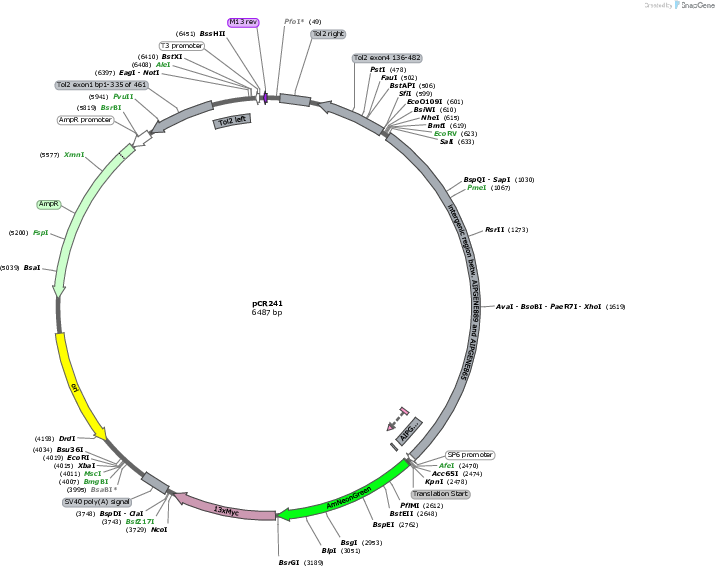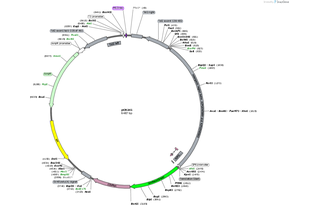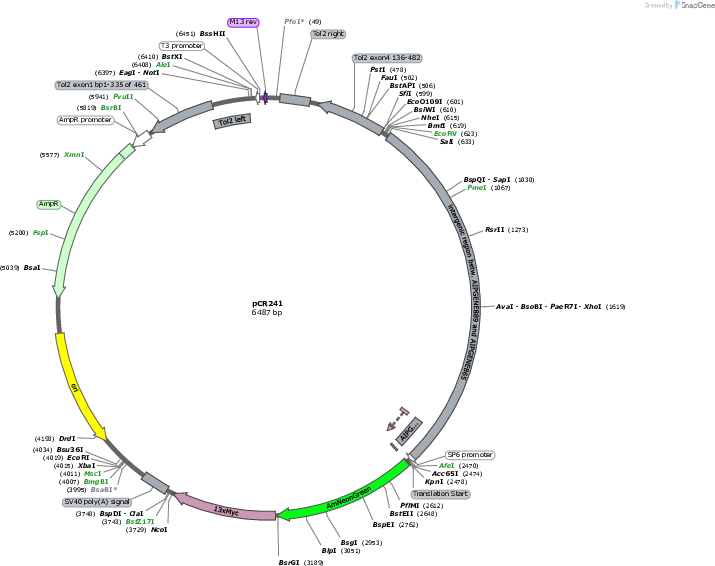pCR241
(Plasmid
#240644)
-
PurposeExpression of AmNeonGreen-13myc in Exaiptasia diaphana; In vitro transcription of the same construct via SP6 polymerase
-
Depositing Lab
-
Publication
-
Sequence Information
Ordering
| Item | Catalog # | Description | Quantity | Price (USD) | |
|---|---|---|---|---|---|
| Plasmid | 240644 | Standard format: Plasmid sent in bacteria as agar stab | 1 | $89 | |
Backbone
-
Vector backbonepT2HE
-
Backbone manufacturerTim Howes
- Backbone size w/o insert (bp) 3366
- Total vector size (bp) 6440
-
Modifications to backboneComplete rearrangement of the elements of the backbone during Gibson Assembly to include oriR and AmpR within Tol2 flanks.
-
Vector typeGene expression and genomic integration in fish
Growth in Bacteria
-
Bacterial Resistance(s)Ampicillin, 100 μg/mL
-
Growth Temperature37°C
-
Growth Strain(s)DH5alpha
-
Copy numberHigh Copy
Gene/Insert 1
-
Gene/Insert nameAIPGENE865 promoter
-
SpeciesExaiptasia diaphana
-
Insert Size (bp)1810
-
Mutationnaturally occurring 749-bp insertion at bp 628 (from bp 1 of plasmid map), corrected exon/intron positions (in agreement with XM_021048156.2).
-
GenBank IDKXJ12416.1 XM_021048156.2
Cloning Information for Gene/Insert 1
- Cloning method Gibson Cloning
- 5′ sequencing primer Tol2right_up_seq_fwd (CTGTTCAGACACCCATATCC), P1_fwd (CGTACGCTAGCGATATCGG)
- 3′ sequencing primer P2A_seq_rev (AGGACCGGGGTTTTCTTCC)
- (Common Sequencing Primers)
Gene/Insert 2
-
Gene/Insert nameSP6 promoter
-
Insert Size (bp)19
Cloning Information for Gene/Insert 2
- Cloning method Gibson Cloning
- 5′ sequencing primer Pag865end_seq_fwd (AAGCGAATTGTGACATTCGTTG)
- (Common Sequencing Primers)
Gene/Insert 3
-
Gene/Insert nameAmNeonGreen
-
SpeciesSynthetic
-
Insert Size (bp)708
-
MutationCodon-optimized for Exaiptasia diaphana, amino acid sequence identical to original mNeonGreen.
-
GenBank IDKC295282.1
-
Tag
/ Fusion Protein
- 13myc (C terminal on insert)
Cloning Information for Gene/Insert 3
- Cloning method Gibson Cloning
- 5′ sequencing primer Pag865end_seq_fwd (AAGCGAATTGTGACATTCGTTG)
- 3′ sequencing primer AmNG_end-49_fwd (AAGCGAATTGTGACATTCGTTG)
- (Common Sequencing Primers)
Resource Information
-
Supplemental Documents
-
A portion of this plasmid was derived from a plasmid made bypT2HE (backbone): O’Brown NM, Summers BR, Jones FC, Brady SD, Kingsley DM. 2015. A recurrent regulatory change underlying altered expression and Wnt response of the stickleback armor plates gene EDA. eLife. 4:e05290. doi:10.7554/eLife.05290. mNeonGreen: Shaner NC, Lambert GG, Chammas A, Ni Y, Cranfill PJ, Baird MA, Sell BR, Allen JR, Day RN, Israelsson M, et al. 2013. A bright monomeric green fluorescent protein derived from Branchiostoma lanceolatum. Nat Methods. 10(5):407–409. doi:10.1038/nmeth.2413. pFA6a-13myc-KanMX6 (source of 13myc tag; Addgene plasmid #39294): Longtine MS, Mckenzie III A, Demarini DJ, Shah NG, Wach A, Brachat A, Philippsen P, Pringle JR. 1998. Additional modules for versatile and economical PCR-based gene deletion and modification in Saccharomyces cerevisiae. Yeast. 14(10):953–961. doi:10.1002/(SICI)1097-0061(199807)14:10<953::AID-YEA293>3.0.CO;2-U.
Terms and Licenses
-
Academic/Nonprofit Terms
-
Industry Terms
- Not Available to Industry
Trademarks:
- Zeocin® is an InvivoGen trademark.
Depositor Comments
The whole intergenic region between AIPGENE865 (KXJ12416.1; Elongation Factor 1alpha) and AIPGENE899 was cloned as promoter fragment. The original gene annotation for AIPGENE865 is incorrect, the automatic NCBI annotation is correct in regards of exons, introns and translation start site. We found that Aiptasia strain CC7 was actually heterozygous for that locus: one allele was mostly in agreement with the genome sources but the other one had a couple of SNPs and a large, 749-bp insert in the intergenic region. The longer version with insert was used as promoter for this plasmid.
AmNeonGreen is a version of mNeonGreen codon-optimized for Aiptasia (based on the transcriptome of Lehnert et al., 2014) with the identical protein sequence.
Lehnert EM, Mouchka ME, Burriesci MS, Gallo ND, Schwarz JA, Pringle JR. 2014. Extensive differences in gene expression between symbiotic and aposymbiotic cnidarians. G3 Bethesda Md. 4(2):277–295. doi:10.1534/g3.113.009084.
These plasmids were created by your colleagues. Please acknowledge the Principal Investigator, cite the article in which the plasmids were described, and include Addgene in the Materials and Methods of your future publications.
-
For your Materials & Methods section:
pCR241 was a gift from John Pringle (Addgene plasmid # 240644 ; http://n2t.net/addgene:240644 ; RRID:Addgene_240644)







